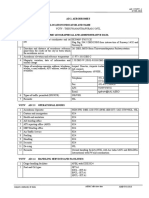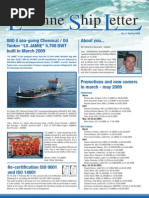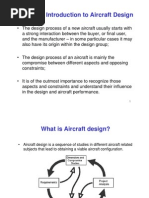Aircraft Sizing
Aircraft Sizing
Uploaded by
Agostino De GiuseppeCopyright:
Available Formats
Aircraft Sizing
Aircraft Sizing
Uploaded by
Agostino De GiuseppeOriginal Title
Copyright
Available Formats
Share this document
Did you find this document useful?
Is this content inappropriate?
Copyright:
Available Formats
Aircraft Sizing
Aircraft Sizing
Uploaded by
Agostino De GiuseppeCopyright:
Available Formats
Aircraft Sizing
The design methods may be divided in different levels: The simplest ones use historical data: for instance the initial weight estimation value may be assumed equal to the weight of the aircraft to be replaced by the present design; The more elaborate ones use all types of software as well as correlations with wind tunnel testing results, etc; Between these lower and higher levels there several other methods for the most part of the design process subtasks as an introduction, an expedite method will be presented to determine the maximum take off weight from an initial sketch. sketch
Take Off Weight g
Take off weight might be divided in several components - crew, payload, fuel and empty weight:
W0 = Wcrew+Wpayload+Wfuel+Wempty W0 take off weight; Wcrew crew weight; i ht Wpayload payload; Wfuel fuel weight; Wempty empty weight;
Wfuel and Wempty may be considered fractions of W0:
W0 = Wcrew+Wpayload+(Wf/W0).W0+(We/W0).W0
Or:
W0-(Wf/W0).W0-(We/W0).W0 = Wcrew+Wpayload
Solving in order to obtain W0:
W0 = ( (Wcrew+Wpayload) )/[1-(W [ ( f/W0) )-(W ( e/W0)]
Empty p y Weight g Estimation
A statistical estimation is used from historical data, , using g the tendency values for the empty weight fraction for different aircraft types; Exponential E ti l representation: t ti
We/W0 = K.A.W0C K = 0,95 composite; K = 1,00 others.
Aircraft Types S il l Sailplane unpowered d Sailplane powered Homebuilt metal/wood Homebuilt composite g engine g General aviation single General aviation twin engine Agricultural aircraft Twin turboprop Flying boat Jet trainer Jet fighter Military cargo/bomber Jet transport A 0 83 0,83 0,88 1,11 1,07 2,05 , 1,40 0,72 0,92 1,05 1 47 1,47 2,11 0,88 0,97 C -0,05 0 05 -0,05 -0,09 -0,09 -0,18 , -0,10 -0,03 -0,05 -0,05 -0,10 0 10 -0,13 -0,07 -0,06
Empty Weight Estimation
Figura 1
Voltar
Mission Scenarios
Fuel Fraction Estimation
Fuel fractions correspondent p to the different mission segments: g
Segment 1. Starting (taxi) and take off 2. Climb 3. Cruise (range) 4. Hold (endurance) 5 Descent 5. D t (may ( be b included i l d d in i 3 or 4) 6. Landing Wi/Wi-1 0,970 0,985 EXP{-R.C.g/[V.(L/D)]} EXP[-E.C.g/(L/D)] 1 000 1,000 0,995
R range [m] C specific p fuel consumption p [kg/Ns] g V velocity [m/s] L/D gliding ratio E endurance or holding time [s]
Fuel Fraction Estimation
Specific Fuel Consumption (cruise at typical altitudes for each engine type):
Consumos especficos a altitudes de cruzeiro tpicas
Fuel Fraction Estimation
Specific p Fuel Consumption p (cont.): ( )
C [mg/Ns] Turbojet Turbofan low bypass Turbofan high bypass Cruise 25,5 22,7 14,1 Hold 22,7 19,8 11,3
For propeller aircrafts the equivalent specific fuel consumption is:
C = Cpower.V/ V/P V velocity [m/s]; P propeller thrust efficiency:
0 0,8 8 for constant speed propellers or fixed pitch in cruise; 0,7 for constant pitch propellers in hold.
Cpower [mg/Ws] Conventional fixed pitch prop Conventional fixed velocity prop Turboprop Cruise 0,068 0,068 0,085 Hold 0,085 0,085 0,101
Fuel Fraction Estimation
Gliding g Ratio estimation:
L/D depends of:
Induced Drag span (b) and aspect ratio (A = b2/S); Parasite Drag wetted area Swet; Wetted aspect ratio b2/Swet = A/(Swet/S); Thus, L/D max strongly depends on the aircraft configuration;
L/D also depends on the mission phase:
L/D Jet Prop Cruise 0,866(L/D)max (L/D)max Hold (L/D)max 0,866(L/D)max
Fuel Fraction Estimation
Figura 2
Voltar
Fuel Fraction Estimation
Voltar
Fuel Fraction Estimation Fuel Fraction estimation:
The total fuel fraction is:
Wf/W0 = 1,06(1-W 1 06(1-WN/W0) The 1,06 coefficient is a correction to account for reserve and residual fuel fractions; WN/W0 = Wn/Wn-1*...Wi/Wi-1*...W1/W0; N is the number of mission phases.
Take Off Weight Calculation
Alternative Method to obtain Wf
Consider Wf independent of W0; Use the mission and a well known engine to determine Wf; The Th take k off ff weight i h may be b estimated i d by: b
W0 = (Wcrew+Wpayload+Wfuel)/[1-(We/W0)]
Example: p surveillance aircraft
Requirements:
Crew 2 (86 kg each); Payload ay oad 50 kg g (ca (camera e a equipment equ p e t and a d parachute); pa ac ute); Cruise speed 180 km/h; Composite structure; Mission:
Example: p surveillance aircraft
Sketches:
Example: p surveillance aircraft
L/D estimation:
AR = 8; Swet/S = 4 (figure 2); Awet = A/(Swet/S) = 8/4 = 2; (L/D)max = 12,5 (figure 3).
Dimensioning:
Taxi and Take Off:
W1/W0 = 0,970;
Climb:
W2/W1 = 0,985;
Example: p surveillance aircraft
Dimensioning g( (cont.): )
Cruise:
R = 300 km = 0,3x106 m; -9 kg/Ws; Cpower = 0,068 , mg/Ws g = 68,0x10 , g ; V = 180 km/h = 50 m/s; P = 0,8; C = Cpower.V/P = 68,0x10-9*50/0,8 = 4,25x10-6 kg/Ns; L/D = (L/D)max = 12,5; W3/W2 = EXP{-RCg/[V(L/D)]}; W3/W2 = EXP[-0,3x106* 4,25x10-6*9,81/(50*12,5)] = EXP(-0,02);
W3/W2 = 0,980; 0 980;
Example: p surveillance aircraft
Dimensioning g( (cont.): )
Surveillance:
E = 2 h = 7200 s; -9 kg/Ws; Cpower = 0,085 , mg/Ws g = 85,0x10 , g ; V = 130 km/h = 36 m/s; P = 0,7; C = Cpower.V/P = 85,0x10-9*36/0,7 = 4,37x10-6 kg/Ns; L/D = 0,866(L/D)max = 0,866*12,5 = 10,825; W4/W3 = EXP[-ECg/ (L/D)]; W4/W3 = EXP(-7200* 4,37x10-6*9,81/10,825) = EXP(-0,0285);
W4/W3 = 0,972; 0 972;
Example: p surveillance aircraft
Dimensioning g( (cont.): )
Cruise (equal to previous cruise phase):
W5/W4 = 0,980;
Hold:
E = 10 min = 600 s; C = 4,37x10-6 kg/Ns; L/D = 10,825; , ; W6/W5 = EXP[-ECg/(L/D)]; W6/W5 = EXP(-600* 4,37x10-6*9,81/10,825) = EXP(-0,0024);
W6/W5 = 0,998;
Descent:
W7/W6 = 1,000;
Landing: g
W8/W7 = 0,995.
Example: p surveillance aircraft
Dimensioning g( (cont.): )
Total:
W8/W0 = W1/W0.W2/W1.W3/W2.W4/W3.W5/W4.W6/W5.W7/W6.W8/W7; W8/W0 = 0,970*0,985*0,980*0,972*0,980*0,998*1,000*0,995; , , , , , , , , ;
W8/W0 = 0,886;
Fuel weight fraction:
Wf/W0 = 1,06(1-W , ( , ( , ); 8/W0) = 1,06*(1-0,886);
Wf/W0 = 0,121;
Empty weight fraction:
We/W0 = 0,95 0 95*2 2,05 05*W W0-0,18 = 1,95W 1 95W0-0,18 (figure 1). 1)
Example: p surveillance aircraft
Dimensioning g( (cont.): )
Take Off weight:
W0 = (Wcrew+Wpayload)/[1-(Wf/W0)-(We/W0)]; -0,18]; W0 = ( (2*86+50)/[1-0,121)[ , 1,95W , 0
W0 = 222/[1-0,121- 1,95W0-0,18]; Take Off weight may be obtained by solving this equation iteratively.
W0 initial [kgf] 600 800 780 765 768
We/W0 0,617 0,585 0,588 0,590 0,590
W0 final [kgf] 847 755 763 768 768
Wcrew = 172 kgf Wp = 50 kgf payload y Wfuel = 93 kgf We = 453 kgf W0 = 768 kgf
Example: p surveillance aircraft
Parametric Studies:
To better understand the effect of chosen parameters on the Take Off weight, parametric studies may be developed; Surveillance time influence:
E = 1 h = 3600 s; W4/W3 = EXP(-3600* 4,37x10-6*9,81/10,825) = EXP(-0,0143); W8/W0 = 0,886*0,986/0,972 = 0,899; Wf/W0 = 1,06*(1-0,899) = 0,107; W0 = 222/[1-0,107- 1,95W0-0,18].
We/W0 0,593 W0 final [kgf] 742 Wcrew = 172 kgf Wpayload = 50 kgf Wfuel = 80 kgf We = 440 kgf W0 = 742 kgf
W0 initial [kgf] 742
Example: p surveillance aircraft
Parametric Studies (cont.): ( )
Surveillance time influence:
E = 3 h = 10800 s;
6*9,81/10,825) W4/W / 3 = EXP(-10800* ( * 4,37x10-6 * / ) = EXP(-0,0428); ( ) W8/W0 = 0,886*0,958/0,972 = 0,873; Wf/W0 = 1,06*(1-0,873) = 0,135; 0 18]. W0 = 222/[1-0,135- 1,95W0-0,18
W0 initial [kgf] 794
We/W0 0,586
W0 final [kgf] 794 Wcrew = 172 kgf Wpayload l d = 50 kgf Wfuel = 107 kgf We = 405 kgf W0 = 794 kgf
Example: p surveillance aircraft
Parametric Studies (cont.): ( )
Cruise distance influence; The following graph shows the influence of the Range and Endurance on the Take Off weight:
900 850 800 W 0 [kgf] 750 700 650 600 0.5 1.0 1.5 2.0 2.5 3.0 3.5 Surveillance Time [h] 100 km 300 km 500 km
Example: p surveillance aircraft
Parametric Studies (cont.): ( )
The influence of other parameters may also be analysed:
Payload Wpayload; Aspect Ratio A; Configuration Swet/S; Etc.. 900
W0 [kgf] 850 500 km
800
300 km
750 3h 700 1h 650 2h
100 km
You might also like
- Moorabbin Class D Procedures Revision 8Document6 pagesMoorabbin Class D Procedures Revision 8Neeth100% (1)
- Quench Cycles Risk Assessment Bike HireDocument4 pagesQuench Cycles Risk Assessment Bike HireNicholasNo ratings yet
- Ship Stability SoftwareDocument7 pagesShip Stability Softwareramy abazaNo ratings yet
- Aurus CVDocument8 pagesAurus CVJerome Beley TevarNo ratings yet
- Flight Dynamics ProjectDocument26 pagesFlight Dynamics ProjectShatha SivamNo ratings yet
- Module 6Document31 pagesModule 6PSkotsNo ratings yet
- 02 Road Maintenance - SummaryDocument12 pages02 Road Maintenance - SummaryRenz FernandezNo ratings yet
- Mini ProjectDocument4 pagesMini Projectሽታ ዓለሜ80% (5)
- EIA DholeraDocument292 pagesEIA DholeraJitendra WadhwaniNo ratings yet
- Schrenk Dan Gaya DalamDocument7 pagesSchrenk Dan Gaya DalamandriaerospaceNo ratings yet
- Aircraft Weight EstimationDocument24 pagesAircraft Weight Estimationgiganticvis50% (2)
- Aircraft Design ReportDocument37 pagesAircraft Design ReportTuğberk ÇakırNo ratings yet
- Duisburg Test Case: Post-Panamax Container Ship For BenchmarkingDocument15 pagesDuisburg Test Case: Post-Panamax Container Ship For BenchmarkingChahbi RamziNo ratings yet
- Disputes On LaytimeDocument18 pagesDisputes On LaytimeDuong TruongNo ratings yet
- Banalagay: Name: Rating: Subj-Sec: InstructorDocument3 pagesBanalagay: Name: Rating: Subj-Sec: InstructorRaymond EdictoNo ratings yet
- What Are Euro Norms For AutomobilesDocument4 pagesWhat Are Euro Norms For AutomobilesRajesh RavindranNo ratings yet
- Calculation of CBMDocument6 pagesCalculation of CBMManish Paul100% (1)
- 19 Rules of InferenceDocument1 page19 Rules of InferenceParity Lugangis Nga-awan IIINo ratings yet
- 095 B777 DG Cargo Loading A41-1Document1 page095 B777 DG Cargo Loading A41-1moqmerNo ratings yet
- Chartering and Brokerin Freighr Revenue CalculationDocument7 pagesChartering and Brokerin Freighr Revenue CalculationDeck OfficerNo ratings yet
- PPS Faizal Kadiwal Ab1Document43 pagesPPS Faizal Kadiwal Ab1ALPESHKUMAR PATEL100% (1)
- Week 4 ExerciseDocument3 pagesWeek 4 ExerciseJohnNo ratings yet
- W&B B777-VNDocument49 pagesW&B B777-VNapi-3705891100% (1)
- 7 TH Sem AdpDocument56 pages7 TH Sem AdpJackson JackNo ratings yet
- BSC Nautical Science 2015 16 PDFDocument173 pagesBSC Nautical Science 2015 16 PDFMerchant Navy PlanetNo ratings yet
- Airtack Freight Limited - Rate Sheet - 2012-10-01Document51 pagesAirtack Freight Limited - Rate Sheet - 2012-10-01Airtack Freight LimitedNo ratings yet
- Guide To BackflipsDocument25 pagesGuide To BackflipsAnkit ANo ratings yet
- 5.2.5. Freeboard (Load Line) : L) S L (TDocument26 pages5.2.5. Freeboard (Load Line) : L) S L (Tisma100% (1)
- Análisis of Ducted Propeller Design 1970-PhD - OosterveldDocument127 pagesAnálisis of Ducted Propeller Design 1970-PhD - Oosterveldfacio8483No ratings yet
- Container Stowage PlanDocument7 pagesContainer Stowage PlanAnenas BalanNo ratings yet
- Helicopter Chapter5Document34 pagesHelicopter Chapter5juanNo ratings yet
- Bridge ProceduresDocument10 pagesBridge ProceduresElton PintoNo ratings yet
- Derivation Navier StokesDocument6 pagesDerivation Navier Stokesvikram_goelNo ratings yet
- Cargo HandlingDocument19 pagesCargo HandlingVinoth VinoNo ratings yet
- Rana Anurag Aeromodelling Lab Final Report 08Document18 pagesRana Anurag Aeromodelling Lab Final Report 08Anurag RanaNo ratings yet
- Application of Calculus in Submarine DesignDocument18 pagesApplication of Calculus in Submarine DesignJohnnyNo ratings yet
- Reeds Vol. 13 Ship Stability, Resistance and Powering 2Document772 pagesReeds Vol. 13 Ship Stability, Resistance and Powering 2hzhchina168No ratings yet
- Ship Hydrodynamics - Lecture - Notes - Part - 7 - Propeller - DesignDocument10 pagesShip Hydrodynamics - Lecture - Notes - Part - 7 - Propeller - DesignOdpewğw RlelelwNo ratings yet
- Ship Operation and ManagementDocument29 pagesShip Operation and ManagementjayNo ratings yet
- Hindustan Shipyard-10Document75 pagesHindustan Shipyard-10anshul21No ratings yet
- Tug Handling 32005enDocument4 pagesTug Handling 32005enClarence PieterszNo ratings yet
- GU 21 Transportation Freight CalculationDocument4 pagesGU 21 Transportation Freight Calculationvicky upreti100% (1)
- E K I PDFDocument7 pagesE K I PDFPrasad SnNo ratings yet
- Ship Brokering and Chartering SyllabusDocument2 pagesShip Brokering and Chartering SyllabusAzlan Khan100% (1)
- Wing Loading During CruiseDocument2 pagesWing Loading During CruiseAina KhairunnisaNo ratings yet
- Triangular Shipment PDFDocument7 pagesTriangular Shipment PDFiiftgscm batch2No ratings yet
- Lecture 9: Ship Weight CalculationsDocument6 pagesLecture 9: Ship Weight CalculationsHussien El-masryNo ratings yet
- Fright Volume CalculationsDocument2 pagesFright Volume CalculationsMuniraju100% (1)
- Safety Data SheetDocument4 pagesSafety Data SheetBryan AntonioNo ratings yet
- Resolving Chronometer Time AmbiguityDocument2 pagesResolving Chronometer Time AmbiguitycskalraNo ratings yet
- AIP VOTV/Thiruvananthapuram Airport, IndiaDocument22 pagesAIP VOTV/Thiruvananthapuram Airport, Indiass khadri100% (1)
- Design of 100 Seater Passenger IrcraftDocument38 pagesDesign of 100 Seater Passenger IrcraftAravind PhoenixNo ratings yet
- Homework Prop Drawing 2010-2011Document4 pagesHomework Prop Drawing 2010-2011bongoyozoNo ratings yet
- Lauranne Shipping 03Document2 pagesLauranne Shipping 03Laurentiu Matei100% (1)
- Civil Aviation Chapter 1 and 2Document43 pagesCivil Aviation Chapter 1 and 2Anjila Bhatta0% (1)
- VCC Manual StoppersDocument13 pagesVCC Manual StoppersarturomNo ratings yet
- Copie de Ship MGT Recovery Jun 2021Document3 pagesCopie de Ship MGT Recovery Jun 2021hassanliouaeddineNo ratings yet
- Weight Estimation - 002 PDFDocument12 pagesWeight Estimation - 002 PDFmurad_ashourNo ratings yet
- Aircraft DesignDocument216 pagesAircraft DesignDivya SrinivasanNo ratings yet
- Constraint DiagramsDocument18 pagesConstraint Diagramsomga747No ratings yet
- Classical Aircraft Sizing I: W. H. MasonDocument19 pagesClassical Aircraft Sizing I: W. H. MasonMir PeerNo ratings yet
- Lecture Note 2Document56 pagesLecture Note 2Tolga Burak UysalNo ratings yet
- 1500 Passenger AircraftDocument14 pages1500 Passenger AircraftrjramanathanNo ratings yet
- Ex.3 210101031,210101032Document9 pagesEx.3 210101031,210101032S BNo ratings yet
- Southern Marine Engineering Desk Reference: Second Edition Volume IFrom EverandSouthern Marine Engineering Desk Reference: Second Edition Volume INo ratings yet
- ASTM F3060 15b.Document14 pagesASTM F3060 15b.Agostino De GiuseppeNo ratings yet
- VSP Cart3d NastranDocument20 pagesVSP Cart3d NastranAgostino De GiuseppeNo ratings yet
- Tails Design PDFDocument19 pagesTails Design PDFAgostino De GiuseppeNo ratings yet
- Lecture 1: Introduction To Aircraft DesignDocument61 pagesLecture 1: Introduction To Aircraft DesignAgostino De GiuseppeNo ratings yet
- Introduction To DesignDocument22 pagesIntroduction To DesignAgostino De GiuseppeNo ratings yet
- Structures and Loads Structures and LoadsDocument39 pagesStructures and Loads Structures and LoadsAgostino De GiuseppeNo ratings yet
- Flight Gear ManualDocument212 pagesFlight Gear ManualAgostino De GiuseppeNo ratings yet
- 15-501-EP-CE-001 Rev.1 (Cause & Effect Diagram)Document2 pages15-501-EP-CE-001 Rev.1 (Cause & Effect Diagram)Umair A. KhanNo ratings yet
- Tata BattriesDocument1 pageTata Battriesvish yadavNo ratings yet
- Simscape Vehicle Templates PDF-مهمDocument126 pagesSimscape Vehicle Templates PDF-مهمali123456784444No ratings yet
- J0231.a - Lashing Design & Calculation, Rev.0Document22 pagesJ0231.a - Lashing Design & Calculation, Rev.0Rustam RiyadiNo ratings yet
- Internship ReportDocument47 pagesInternship ReportMohammed SaalimNo ratings yet
- JurisdictionDocument73 pagesJurisdictionIndia Contract100% (1)
- The Lived Experiences of Women With Different Somatotypes On Public Transportation: A Phenomenological StudyDocument101 pagesThe Lived Experiences of Women With Different Somatotypes On Public Transportation: A Phenomenological StudyCaitlyn CombateNo ratings yet
- Working Party On Road Traffic Safety (Sixty-Seventh Session) New Delhi, (4 - 6) December 2013Document36 pagesWorking Party On Road Traffic Safety (Sixty-Seventh Session) New Delhi, (4 - 6) December 2013pyay kanung kyawNo ratings yet
- Oman Tel ContainerDocument28 pagesOman Tel ContainerkrishnakumarsistNo ratings yet
- Aerodrome Directory For Light Aircraft (ALA) : Nusa Tenggara Aip Indonesia (Vol. Iv) East Nusa TenggaraDocument6 pagesAerodrome Directory For Light Aircraft (ALA) : Nusa Tenggara Aip Indonesia (Vol. Iv) East Nusa TenggaraandyNo ratings yet
- Inbound Opus 08Document33 pagesInbound Opus 08Dhez RoblesNo ratings yet
- Pronto RosterDocument30 pagesPronto Rosterstarwang1107No ratings yet
- Automatic Movable Railway Platform With Train Arrival Detection and Monitoring Over Internet of Things (IoT)Document3 pagesAutomatic Movable Railway Platform With Train Arrival Detection and Monitoring Over Internet of Things (IoT)Anonymous Ndsvh2so50% (2)
- Grid References BookletDocument10 pagesGrid References Bookletvaishnavimadan100% (2)
- TCL LED TV Spare Part Request Form: Total QuantityDocument12 pagesTCL LED TV Spare Part Request Form: Total QuantityMuhammad Galang AlvianNo ratings yet
- Path BrochureDocument2 pagesPath Brochures.chabot4130No ratings yet
- Pages From Catalogue 2014-JetfanDocument4 pagesPages From Catalogue 2014-JetfanPhanhai KakaNo ratings yet
- Extraordinary DiligenceDocument12 pagesExtraordinary DiligenceKatrina PerezNo ratings yet
- RAILWAY - Safety Workspot 3Document3 pagesRAILWAY - Safety Workspot 3Viswanadh Lvs KuchibhotlaNo ratings yet
- Actis OHS GuidelinesDocument32 pagesActis OHS GuidelineswvolpeNo ratings yet
- Driver's Handbook 2024-25Document192 pagesDriver's Handbook 2024-25syed saifNo ratings yet
- La's (9kv 5ka Line Type) (Ot-155)Document12 pagesLa's (9kv 5ka Line Type) (Ot-155)Yaswanth ReddyNo ratings yet
- Tunnel Ventilation Design SolutionDocument27 pagesTunnel Ventilation Design SolutionRitesh Singh100% (2)
- Redtaxi InvoiceDocument3 pagesRedtaxi Invoicesirivaishnavi25No ratings yet
- Staff Manual: Benefits On Assignment Away From HeadquartersDocument16 pagesStaff Manual: Benefits On Assignment Away From Headquartersmohammedkedir143No ratings yet
































































































